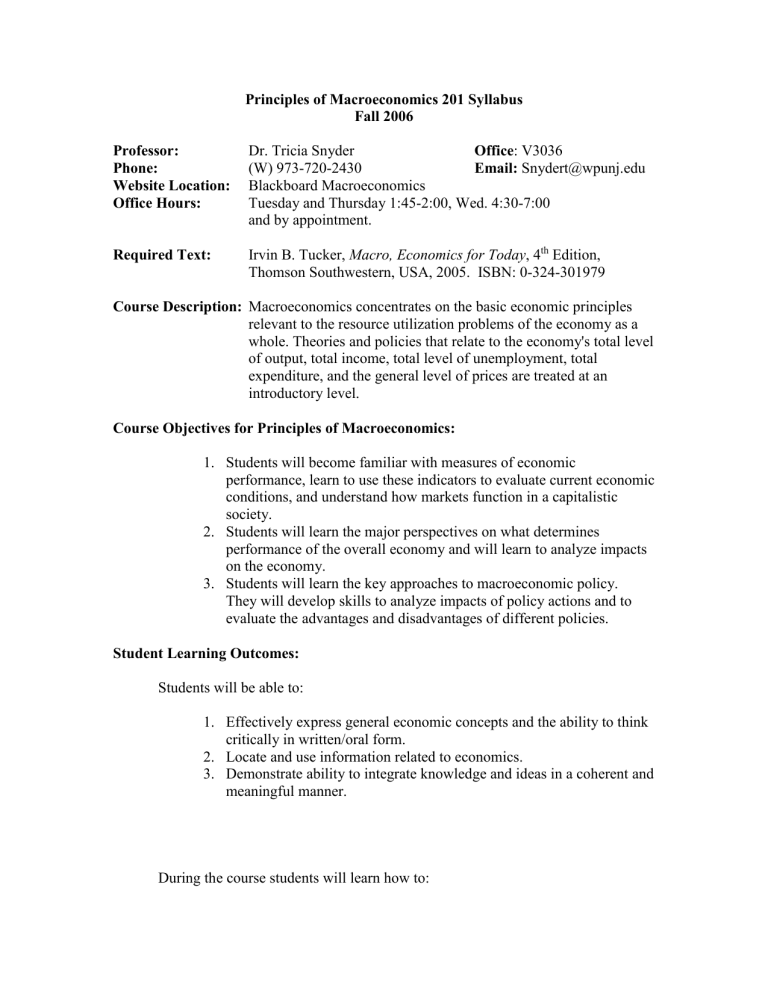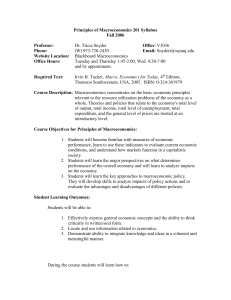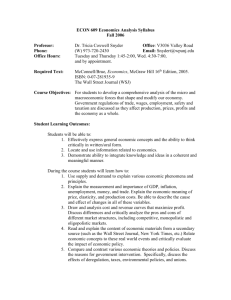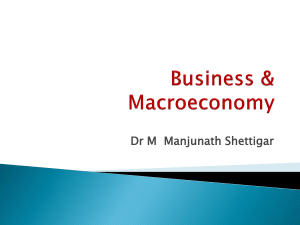
Principles of Macroeconomics 201 Syllabus Fall 2006 Professor: Phone: Website Location: Office Hours: Dr. Tricia Snyder Office: V3036 (W) 973-720-2430 Email: Snydert@wpunj.edu Blackboard Macroeconomics Tuesday and Thursday 1:45-2:00, Wed. 4:30-7:00 and by appointment. Required Text: Irvin B. Tucker, Macro, Economics for Today, 4th Edition, Thomson Southwestern, USA, 2005. ISBN: 0-324-301979 Course Description: Macroeconomics concentrates on the basic economic principles relevant to the resource utilization problems of the economy as a whole. Theories and policies that relate to the economy's total level of output, total income, total level of unemployment, total expenditure, and the general level of prices are treated at an introductory level. Course Objectives for Principles of Macroeconomics: 1. Students will become familiar with measures of economic performance, learn to use these indicators to evaluate current economic conditions, and understand how markets function in a capitalistic society. 2. Students will learn the major perspectives on what determines performance of the overall economy and will learn to analyze impacts on the economy. 3. Students will learn the key approaches to macroeconomic policy. They will develop skills to analyze impacts of policy actions and to evaluate the advantages and disadvantages of different policies. Student Learning Outcomes: Students will be able to: 1. Effectively express general economic concepts and the ability to think critically in written/oral form. 2. Locate and use information related to economics. 3. Demonstrate ability to integrate knowledge and ideas in a coherent and meaningful manner. During the course students will learn how to: 1. Use supply and demand to explain various economic phenomena and principles. 2. Explain the measurement and importance of GDP, inflation, unemployment, money, and trade. Be able to describe the cause and effect of changes in all of these variables. 3. Read and explain the content of economic materials from a secondary source (such as the Wall Street Journal, New York Times, etc.) Relate economic concepts to these real world events and critically evaluate the impact of economic policy. 4. Compare and contrast various economic theories and policies. This includes being able to critically analyze the Neo-Classical, Monetarists, and Keynesian theories and policies. Topical Outline of the Course Content: SUBJECT Introduction to Economics Introducing the Economic Way of Thinking Key Principles – Production Possibilities Curve, Opportunity Cost, and Economic Growth Market Demand and Supply Markets in Action READINGS Ch. 1 Ch. 2 Ch. 3 Ch. 4 Introduction to Macroeconomics Measuring economic performance and Introduction to economic indicators Gross Domestic Product (GDP) Business Cycles and Unemployment Inflation WSJ, E-Trade Ch. 5 Ch. 6 Ch. 7 Exam 1 (25%) Ch. 1-7 Macroeconomic Theory and Policy The Keynesian Model and the Components of AD The Keynesian Model/ Consumption Function The Keynesian Model in Action/Components of AD Ch. 8 Ch. 9 Fiscal Policy Fiscal Policy Public Sector Federal Deficits, Surpluses, and National Debt Ch. 11 Ch. 12 Ch. 13 Money, Banking and Monetary Policy Money and the Federal Reserve System Money Creation Monetary Policy Ch. 14 Ch. 15 Ch. 16 Exam II (25%) Ch. 8,9,11-16 Economic Stability/Macroeconomic Theories Aggregate Demand and Supply The Phillips Curve and Expectations Theory Ch. 10 Ch. 17 The International Economy International Trade and Finance Ch. 18 (Cumulative) FINAL EXAM (25%) All Chapters Grading Policy Class participation: Attendance is strongly encouraged, as all exam questions will come directly from class discussion. Class participation will not count directly towards your final grade, but will be considered if you are on the margin between grades. Homework Assignments: In-Class Problems and Take Home Assignments will count for 5% of your final grade. The Economic Indicators Project: Tests: Students should track present economic indicators in an excel spreadsheet and as a graph overtime. Students should then analyze the values of these economic indicators. The project is worth 20% of your final grade. 3 Tests will be given, each test is weighted equally and is worth 25% of your final grade. The Final is Cumulative! NO MAKE-UP EXAMS will be given, under any circumstance. There will be NO exceptions. If you must miss an exam, the exam grade will be replaced with your final exam grade, making the final exam count for 50% of your final grade. If you cheat at anytime during the course, you will receive a final grade of an F for the course. If you have a question – ASK!!! If I am going to fast, please ask me to slow down. To help encourage the proper educational environment and out of courtesy for your fellow classmates, please turn of all cell phones and pagers prior to entering the classroom and be on time.



